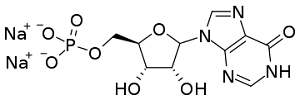Disodium Inosinate

Product Description
Disodium inosinate is a flavor enhancer commonly used in the food industry to improve the taste of various products.
Product:
Disodium Inosinate
CAS:
4691-65-0
Synonym:
Disodium 5′-inosinate; 5′-Inosinic acid, disodium salt
Structure:

Typical Characteristics
Appearance
Colorless or white crystals or powder
Density
2.31 g/cm3
Melting point
175 °C
Molecular Weight
392.17
Odor
Odorless
Purity
≥99%
Uses, Applications & Markets
Key applications
Markets
get a quote
We Offer Disodium Inosinate
in various grades
A few of the grades available are listed below:



Disodium Inosinate used in many
industry applications
Disodium inosinate is a flavor enhancer commonly used in the food industry to improve the taste of various products. Here are some of its industrial applications:
- Food Additive: Disodium inosinate is extensively used as a flavor enhancer in processed foods, such as soups, sauces, snacks, and savory snacks. It works synergistically with monosodium glutamate (MSG) to enhance umami taste perception, making food products more palatable.
- Seasoning Blends: It is included in seasoning blends and spice mixes to intensify the savory flavor profile and enhance overall taste perception in culinary preparations.
- Instant Noodles: Disodium inosinate is a common ingredient in instant noodle seasoning packets, where it enhances the savory taste of the broth and complements other flavoring agents, such as soy sauce and spices.
- Processed Meats: It is used in the production of processed meats, such as sausages, hot dogs, and cured meats, to improve flavor perception and mask undesirable off-flavors associated with meat processing.
- Soups and Broths: Disodium inosinate is added to canned soups, bouillons, and broth concentrates to enhance the depth of flavor and provide a richer taste experience, particularly in meat-based and vegetable-based formulations.
- Snack Foods: It is incorporated into snack food formulations, including potato chips, crackers, and savory snacks, to boost the savory flavor profile and increase consumer appeal.
- Ready-to-Eat Meals: Disodium inosinate is used in the preparation of ready-to-eat meals and convenience foods to enhance flavor intensity and improve taste satisfaction, especially in shelf-stable and microwaveable products.
- Sauces and Dressings: It is included in sauce formulations, such as barbecue sauce, soy sauce, and salad dressings, to enhance flavor complexity and add depth to the overall taste profile.
- Condiments: Disodium inosinate is added to condiments, such as ketchup, mustard, and mayonnaise, to amplify flavor perception and create a more appealing sensory experience for consumers.
- Flavor Synergist: It is often used in combination with other flavor enhancers, such as monosodium glutamate (MSG) and disodium guanylate, to create synergistic flavor profiles that mimic the taste of natural umami-rich ingredients.